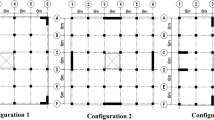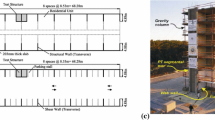Abstract
Two existing RC shear wall buildings of 17 and 26 stories were analyzed using fully nonlinear finite element models, i.e., models that include nonlinear material behavior and geometric nonlinearities. The buildings are located in Santiago, Chile and are representative of Chilean residential buildings in the sense that they have a large number of shear walls. The buildings withstood undamaged the 2010 Chile earthquake even though they were subjected to demands much larger than the code-specified demand. The approach to model the RC shear walls was validated through comparisons with results experimentally obtained from cyclic static tests conducted on isolated wall specimens. Several pushover analyses were performed to assess the global response of the buildings under seismic actions and to evaluate the influence of several modeling issues. Response history analyses were performed considering a ground motion recorded in Santiago during the 2010 Chile earthquake. In general, results (in terms of both global and local response quantities) are consistent with results given by pushover analysis and with the empirically observed lack of damage, a consistency that was not found in a previous study that considered linearly elastic models. The tangential inter-story drift deformation was found to correlate much better with the lack of observable damage than the total inter-story drift deformation typically considered in practice. The analysis also revealed that foundation uplift is possible but does not seem to significantly influence the response. Other modeling issues that were found to deserve further research are the shear stiffness of the walls and the influence of the slabs.














Similar content being viewed by others
References
ACI (2014) Building code requirements for reinforced concrete. ACI 318-14. American Concrete Institute, Farmington Hill, USA
Alarcon C (2013) Influence of axial load in seismic behavior of reinforced concrete wallas with nonseismic detailing. M.S. Thesis, Department of Structural & Geotechnical Engineering, Pontificia Universidad Católica de Chile, Santiago, Chile
Alarcon C, Hube MA, Junemann R, de la Llera JC (2015) Characteristics and displacement capacity of reinforced concrete walls in damaged buildings during 2010 Chile earthquake. Bull Earthq Eng 13:1119–1139
ASCE (2014) Seismic evaluation and retrofit of existing buildings ASCE Standard. ASCE/SEI 41-13. American Society of Civil Engineers, Reston, USA
ASCE (2017) Minimum design loads and associated criteria for buildings and other structures. ASCE/SEI 7-16. American Society of Civil Engineers, Reston, USA
ATC (1996) Seismic evaluation and retrofit of concrete buildings. Rep. ATC-40. Applied Technology Council, Redwood City, USA
ATC (2010) Modeling and acceptance criteria for seismic design and analysis of tall buildingss. Rep. PEER/ATC-72-1. Applied Technology Council, Redwood City, USA
Bonelli P, Restrepo JI, Boroschek R, Carvallo JF (2012) The 2010 great Chile earthquake—changes to design codes. In: International symposium on engineering lessons learned from the 2011 Great East Japan Earthquake. Tokio, Japan, pp 1778–1787
Carpenter LD, Naeim F, Lew M et al (2011) Performance of tall buildings in Viña del Mar in the 27 February 2010. Struct Des Tall Spec Build 20:17–36
CSI (2016a) PERFORM-3D™: nonlinear analysis and performance assessment for 3D structures, version 6.0.0. Computers and Structures Inc, Walnut Creek, USA
CSI (2016b) Components and elements for PERFORM-3D™ version 6. Computers and Structures Inc, Walnut Creek, USA
CSI (2016c) User guide, PERFORM-3D™. Computers and Structures Inc, Walnut Creek, USA
Değer ZT, Yang TY, Wallace JW, Moehle JP (2015) Seismic performance of reinforced concrete core wall buildings with and without moment resisting frames. Struct Des Tall Spec Build 24:477–490
Deierlein GG, Reinhorn AM, Willford MR (2010) Nonlinear structural analysis for seismic design. Rep. NIST GCR 10-917-5. NEHRP Consultants Joint Venture, Gaithersburg, USA
FIB (2003) Displacement-based seismic design of reinforced-concrete buildings. State-of-the-art Rep. Bulletin 25. Fédération Internationale du Beton, Lausanne, Switzerland
Gerin M, Adebar P (2004) Accounting for shear in seismic analysis of concrete structures. In: 13th world conference on earthquake engineering. Vancouver, Canada
Hube MA, Vizcaino P, Lopez-Garcia D, de la Llera JC (2012) Study on partial collapse of a five story reinforced concrete building during the 2010 Chile earthquake. In: 15th world conference on earthquake engineering. Lisbon, Portugal
Humar J, Rahgozar M (1996) Concept of overstrength in seismic design. In: 11th world conference on earthquake engineering. Acapulco, México
INN (1996) Norma Chilena Oficial NCh433.Of96: Diseño sísmico de edificios. Instituto Nacional de Normalización, Santiago, Chile (In Spanish)
Jain S, Navin R (1995) Seismic overstrength in reinforced concrete frames. J Struct Eng 121:580–585
Junemann R, de la Llera JC, Hube MA et al (2015) A statistical analysis of reinforced concrete wall buildings damaged during the 2010, Chile earthquake. Eng Struct 82:168–185
Junemann R, de la Llera JC, Hube MA et al (2016) Study of the damage of reinforced concrete shear walls during the 2010 Chile earthquake. Earthq Eng Struct Dyn 45:1621–1641
Kayen RE, Carkin BD, Corbet S, et al (2014) Seismic velocity site characterization of thirty-one Chilean seismometer stations by spectral analysis of surface wave dispersion. Technical Report PEER 2014/05. Earthquake Engineering Research Center, University of California Berkeley, Berkeley, USA
Kolozvari K, Wallace JW (2016) Practical nonlinear modeling of reinforced concrete structural walls. J Struct Eng 142:G4016001
Kolozvari K, Piatos G, Beyer K (2017) Practical nonlinear modeling of U-shaped reinforced concrete walls under bi-directional loading. In: 16th world conference on earthquake engineering. Santiago, Chile
Lagos R, Kupfer M, Lindenberg J et al (2012) Seismic performance of high-rise concrete buildings in Chile. Int J High Rise Build 1:181–194
LATBSDC (2015) An alternative procedure for seismic analysis and design of tall buildings located in the Los Angeles Region. Los Angeles Tall Buildings Structural Design Council, Los Angeles, USA
Lowes LN, Lehman DE, Baker C (2016) Recommendations for modeling the nonlinear response of slender reinforced concrete walls using PERFORM-3D. In: 2016 SEAOC convention. Maui, USA
Mander JB, Priestley MJN, Park R (1988) Theoretical stress-strain model for confined concrete. J Struct Eng 114:1804–1826
Massone LM, Bonelli P, Lagos R et al (2012) Seismic design and construction practices for RC structural wall buildings. Earthq Spectra 28:S245–S256
McKenna F, Fenves G, Scott M (2000) Open system for earthquake engineering simulation (OpenSees) version 2.5.0. Pacific Earthquake Engineering Research Center, Berkeley, USA
Naeim F, Lew M, Carpenter LD et al (2011) Performance of tall buildings in Santiago, Chile during the 27 February 2010 offshore Maule, Chile earthquake. Struct Des Tall Spec Build 20:1–16
Newmark NM (1959) A method of computation for structural dynamics. J Eng Mech Div 85:67–94
Orakcal K, Wallace JW (2006) Flexural modeling of reinforced concrete walls—experimental verification. ACI Struct J 103:196–206
Panagiotou M, Restrepo JI, Conte JP (2010) Shake-table test of a full-scale 7-story building slice. Phase I: rectangular wall. J Struct Eng 137:691–704
Parra PF, Moehle JP (2014) Lateral buckling in reinforced concrete walls. In: 10th US national conference on earthquake engineering. Anchorage, USA
Paulay T, Priestley MJN (1992) Seismic design of reinforced concrete and masonry buildings. Wiley, New York, USA
Powell GH (2007) Detailed example of a tall shear wall building using CSI’s PERFORM 3D nonlinear dynamic analysis. Computers and Structures Inc, Berkeley, USA
Priestley MJN, Park R (1987) Strength and ductility of concrete bridge columns under seismic loading. ACI Struct J 84:61–76
Restrepo JI, Conte JP, Dunham RS et al (2017) Detailed nonlinear FE pushover analysis of Alto Rio building. In: 16th world conference on earthquake engineering. Santiago, Chile
Rojas F, Naeim F, Lew M et al (2011) Performance of tall buildings in Concepcion during the 27 February 2010 moment magnitude 8.8 offshore Maule, Chile earthquake. Struct Des tall Spec Build 20:37–64
Song C, Pujol S, Lepage A (2012) The collapse of the Alto Río building during the 27 February 2010 Maule, Chile, earthquake. Earthq Spectra 28:S301–S334
Telleen K, Maffei J, Willford M, et al (2012) Lessons for concrete wall design from the 2010 Maule Chile earthquake. In: International symposium on engineering lessons learned from the 2011 Great East Japan Earthquake. Tokio, Japan, pp 1766–1777
Thomsen JH, Wallace JW (1995) Displacement based design of reinforced concrete structural walls: an experimental investigation of walls with rectangular and T-shaped cross-sections. Report No. CU/CEE-95/06. Department of Civil and Enviromental Engineering, Clarkson University, Potsdam, USA
Ugalde D, Lopez-Garcia D (2017a) Elastic overstrength of reinforced concrete shear wall buildings in Chile. In: 16th world conference on earthquake engineering. Santiago, Chile
Ugalde D, Lopez-Garcia D (2017b) Behavior of reinforced concrete shear wall buildings subjected to large earthquakes. In: X International conference on structural dynamics (EURODYN). Roma, Italy
Wallace JW (2011) February 27, 2010 Chile earthquake: preliminary observations on structural performance and implications for US building codes and standards. In: Structures congress 2011. Las Vegas, USA, pp 1672–1685
Wallace JW, Massone LM, Bonelli P et al (2012) Damage and implications for seismic design of RC structural wall buildings. Earthq Spectra 28:S281–S299
Westenenk B, de la Llera JC, Junemann R et al (2013) Analysis and interpretation of the seismic response of RC buildings in Concepción during the February 27, 2010, Chile earthquake. Bull Earthq Eng 11:69–91
Wood SL (1991) Performance of reinforced concrete buildings during the 1985 Chile earthquake: implications for the design of structural walls. Earthq Spectra 7:607–638
Zhang P, Restrepo JI, Conte JP, Ou J (2017) Nonlinear finite element modeling and response analysis of the collapsed Alto Rio building in the 2010 Chile Maule earthquake. Struct Des Tall Spec Build 26:e1364
Acknowledgements
The authors are grateful to VMB Structural Engineering (Santiago, Chile) for providing information on the buildings analyzed in this paper and valuable comments on the Chilean structural engineering practice. The first author’s doctoral studies were financially supported by the Chilean National Commission for Scientific and Technological Research (CONICYT) through the CONICYT-PCHA/Doctorado Nacional/2015-21151184 scholarship. Further support was provided by the National Research Center for Integrated Natural Disaster Management (CIGIDEN) CONICYT FONDAP 15110017. This support is gratefully acknowledged.
Author information
Authors and Affiliations
Corresponding author
Additional information
Publisher's Note
Springer Nature remains neutral with regard to jurisdictional claims in published maps and institutional affiliations.
Rights and permissions
About this article
Cite this article
Ugalde, D., Parra, P.F. & Lopez-Garcia, D. Assessment of the seismic capacity of tall wall buildings using nonlinear finite element modeling. Bull Earthquake Eng 17, 6565–6589 (2019). https://doi.org/10.1007/s10518-019-00644-x
Received:
Accepted:
Published:
Issue Date:
DOI: https://doi.org/10.1007/s10518-019-00644-x




